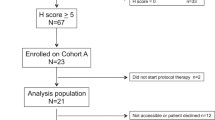Abstract
Early clinical trials of anticancer agents may be enriched by robust biomarkers of activity. Surrogate measures used in trials of cytotoxic agents, such as tumor size regression, may not be informative when investigating targeted agents that act principally to inhibit invasion or proliferation. This study aimed to determine the validity of invasion-related biomarkers of activity for AZD0530, a potent Src inhibitor currently in clinical development. Focal adhesion kinase (FAK) and paxillin are downstream phosphorylation substrates of Src and mediate tumor cell adhesion and invasiveness. These were therefore selected as biologically relevant markers of Src inhibition. Early breast cancer was chosen as a model as multiple samples can be collected during standard treatment and there is an intervening period in which experimental intervention can be applied. Tumor tissue was collected from diagnostic core biopsies and subsequent surgical tumor excision samples in 29 women with early breast cancer attending a single center. Protein levels were assessed quantitatively by Luminex® and qualitatively by immunohistochemistry. AZD0530 inhibited tumor growth in a manner independent of dose and inhibited phosphorylation of FAK and paxillin in a dose-dependent manner in a Calu-6 xenograft model. In the clinical study, agreement of within-visit and also of between-visit measurements was high and the estimated number of patients required to detect a drug effect would be low enough to allow use of these markers as endpoints in future dose selection studies.







Similar content being viewed by others
Notes
Calu-6 nude female rats were generated by Oncodesign (Dijon, France).
References
Frame MC (2004) Newest findings on the oldest oncogene; how activated src does it. J Cell Sci 117:989–998
Irby RB, Yeatman TJ (2000) Role of Src expression and activation in human cancer. Oncogene 19:5636–5642
Ottenhoff-Kalff AE, Rijksen G, van Beurden EA et al (1992) Characterization of protein tyrosine kinases from human breast cancer: involvement of the c-src oncogene product. Cancer Res 52:4773–4778
Verbeek BS, Vroom TM, Adriaansen-Slot SS et al (1996) c-Src protein expression is increased in human breast cancer An immunohistochemical and biochemical analysis. J Pathol 180:383–388
Reissig D, Clement J, Sanger J et al (2001) Elevated activity and expression of Src-family kinases in human breast carcinoma tissue versus matched non-tumor tissue. J Cancer Res Clin Oncol 127:226–230
Ito Y, Kawakatsu H, Takeda T et al (2002) Activation of c-Src is inversely correlated with biological aggressiveness of breast carcinoma. Breast Cancer Res Treat 76:261–267
Rucci N, Recchia I, Angelucci A et al (2006) Inhibition of protein kinase c-Src reduces the incidence of breast cancer metastases and increases survival in mice: implications for therapy. J Pharmacol Exp Ther 318:161–172
Hiscox S, Morgan L, Jordan NJ et al (2007) Src kinase promotes adhesion-independent activation of FAK and enhances cellular migration in tamoxifen resistant breast cancer cells. Clin Exp Metastasis 24:157–167
Hiscox S, Morgan L, Green TP et al (2006) Elevated Src activity promotes cellular invasion and motility in tamoxifen resistant breast cancer cells. Breast Cancer Res Treat 97:263–274
Finn RS, Dering J, Ginther C et al (2007) Dasatinib, an orally active small molecule inhibitor of both the src and abl kinases, selectively inhibits growth of basal-type/“triple-negative” breast cancer cell lines growing in vitro. Breast Cancer Res Treat 105:319–326
Hiscox S, Morgan L, Green T et al (2006) Src as a therapeutic target in anti-hormone/anti-growth factor-resistant breast cancer. Endocr Relat Cancer 13(Suppl 1):S53–S59
Green T, Hennequin LF, Ple PA et al (2005) Pre-clinical and early clinical activity of the highly selective, orally available, dual Src/Abl kinase inhibitor AZD0530. AACR Annual Meeting SSY01 Drugs on the Horizon Symposium
McLean GW, Fincham VJ, Frame MC (2000) v-Src induces tyrosine phosphorylation of focal adhesion kinase independently of tyrosine 397 and formation of a complex with Src. J Biol Chem 275:23333–23339
Rodina A, Schramm K, Musatkina E et al (1999) Phosphorylation of p125FAK and paxillin focal adhesion proteins in src-transformed cells with different metastatic capacity. FEBS Lett 455:145–148
Jones RJ, Boyce T, Fennell M et al (2008) The impact of delay in cryo-fixation on biomarkers of Src tyrosine kinase activity in human breast and bladder cancers. Cancer Chemother Pharmacol 61:23–32
Kawakatsu H, Sakai T, Takagaki Y et al (1996) A new monoclonal antibody which selectively recognizes the active form of Src tyrosine kinase. J Biol Chem 271:5680–5685
Marchetti S, Schellens JH (2007) The impact of FDA and EMEA guidelines on drug development in relation to Phase 0 trials. Br J Cancer 97:577–581
Booth B, Glassman R, Ma P (2003) Oncology’s trials. Nat Rev Drug Discov 2:609–610
Frame MC (2002) Src in cancer: deregulation and consequences for cell behaviour. Biochim Biophys Acta 1602:114–130
Author information
Authors and Affiliations
Corresponding author
Rights and permissions
About this article
Cite this article
Jones, R.J., Young, O., Renshaw, L. et al. Src inhibitors in early breast cancer: a methodology, feasibility and variability study. Breast Cancer Res Treat 114, 211–221 (2009). https://doi.org/10.1007/s10549-008-9997-1
Received:
Accepted:
Published:
Issue Date:
DOI: https://doi.org/10.1007/s10549-008-9997-1




